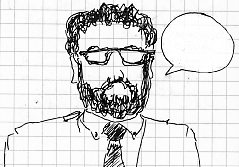Thursday, August 31, 2006
A Big Green Choice
(Major spoilers to She Hulk #11 follow.)
Dan Slott's She-Hulk is one of the titles that lured me back into comics, and though there have been some bumps in the road (specifically the Starfox flashback), I've really been enjoying his take on the character.
Civil War is tearing up the Marvel Universe and cracking the Internets in half, right? In She Hulk #10, Slott has the She-Hulk (who is pro-Registration) work to convince an unregistered fellow heroine to see the issue from her point of view. She succeeds, even though she has dropped in on the heroine in the midst of a chase.
(And now that I think of it, that crafty Slott depicted the entire Marvel Universe engaging not in a civil war, but in a fun-filled poker tournament in The Thing #8.)
The latest helping of Shulkie-based goodness was served up in issue #11: on the comic's final page Man-Wolf offers Jennifer a choice that gets to the heart of who she is.
Here's the crucial exchange:

Let's be clear: Man-Wolf is exerting emotional coercion in an attempt to force Jennifer to do what he's wanted all along. At every turn he's been pushing her to reject the She-Hulk part of her being, because he'd prefer that she embody the Jennifer Walters portion of her self 24/7. Jameson has always made it obvious that he loves Jennifer, but is less-than-fond of the She-Hulk.
But isn't Jennifer the She-Hulk? Isn't Jameson's discomfort with, and rejection of, the She Hulk also a rejection of Jennifer?
I've always assumed that the She-Hulk + Jennifer formed a single complex identity, and as I've been reading the Jennifer/Jameson story arc, I haven't been certain that Slott would push the character to face the interesting existential ambiguity that's at the heart of her personality.
But he has. And I'm not ashamed to say that I am exhilarated that he's done so.
Dan Slott's She-Hulk is one of the titles that lured me back into comics, and though there have been some bumps in the road (specifically the Starfox flashback), I've really been enjoying his take on the character.
Civil War is tearing up the Marvel Universe and cracking the Internets in half, right? In She Hulk #10, Slott has the She-Hulk (who is pro-Registration) work to convince an unregistered fellow heroine to see the issue from her point of view. She succeeds, even though she has dropped in on the heroine in the midst of a chase.
(And now that I think of it, that crafty Slott depicted the entire Marvel Universe engaging not in a civil war, but in a fun-filled poker tournament in The Thing #8.)
The latest helping of Shulkie-based goodness was served up in issue #11: on the comic's final page Man-Wolf offers Jennifer a choice that gets to the heart of who she is.
Here's the crucial exchange:

Let's be clear: Man-Wolf is exerting emotional coercion in an attempt to force Jennifer to do what he's wanted all along. At every turn he's been pushing her to reject the She-Hulk part of her being, because he'd prefer that she embody the Jennifer Walters portion of her self 24/7. Jameson has always made it obvious that he loves Jennifer, but is less-than-fond of the She-Hulk.
But isn't Jennifer the She-Hulk? Isn't Jameson's discomfort with, and rejection of, the She Hulk also a rejection of Jennifer?
I've always assumed that the She-Hulk + Jennifer formed a single complex identity, and as I've been reading the Jennifer/Jameson story arc, I haven't been certain that Slott would push the character to face the interesting existential ambiguity that's at the heart of her personality.
But he has. And I'm not ashamed to say that I am exhilarated that he's done so.
Tuesday, August 29, 2006
Recent Reading
Several of the interviews in the 30th anniversary issue of The Comics Journal (#277) deal with the question of diversity in the comics offered by publishers; two struck me as particularly focussed.
The first was with Diana Schutz, someone who has been working in comics for close to thirty years. She's presently a senior editor at Dark Horse Comics, overseeing primarily creator-owned titles. (She's interviewed by Dirk Deppey.)
The first was with Diana Schutz, someone who has been working in comics for close to thirty years. She's presently a senior editor at Dark Horse Comics, overseeing primarily creator-owned titles. (She's interviewed by Dirk Deppey.)
DEPPEY: ... I'm wondering if it's possible to build a market at this point that features a wide variety of material ...
SCHUTZ: (Sighs.) This is something that Dark Horse has struggled with, in terms of publishing across the board, from adventure comics to more sophisticated, more literary graphic novels ... I mean, at the end of the day, it comes down to good stories . ...
I mean crunching out comics on a monthly deadline and attempting to create literature under those kinds of commerical constraints — the deck is stacked against you, you know? You have to meet deadlines. A new script has to be written every month. It has to be penciled by one person in one month, inked by another person in another month, and lettered and colored — and certain editors at some companies apparently have a vested interest in keeping those freelance artists from talking to each other! Of course you're not going to produce literature under those circumstances!
...The second interview was with Dallas Middaugh, the Associate Editor of Del Rey Manga (a division of Random House). Though I don't think I'm comfortable with the stark boys like this, and girls like that formulation he uses at the end of this excerpt, I do think he is onto something when he contrasts American and Japanese comic publisers.
I'd like to see more focus on story — at the snooty end of comics (laughter), I'd like to see better stories as opposed to "Oh, I'm just going to diddle myself with my art and talk about my bathroom habits for the rest of this book." I'd like to have more entertaining stories. I prefer to read something that's more demanding of me as a reader.
La Perdida, for instance — it's recently come out in book form, so it's very present in my mind. I think La Perdida is exactly where I'd like to see the comics biz move. It's beautifully drawn, it's a solid, involving story, it makes a very well thought-out use of the medium, and it has the potential to open doors to far more readers than the comic-book set. ... Far too much of what I see at that end of the spectrum really doesn't have good story. ...
Superheroes will stifle this marketplace if they continue to dominate, I think, but by the same token, I don't want to see the genre abolished. I loved superhero comics when I was a little girl, now I love work like La Perdida, and a healthy market makes room for both and everything in between.
MIDDAUGH: Look, I think superheroes are a perfectly valid genre for comics, but the fact remains that only so many people are going to be interested in reading about them. I mean, let's take a story about someone finding a magic ring. In manga, the story would focus about how the ring changed that person's relationships, how it affected his life, and how his everyday circumstances would be different — and there would be adventures, too, but that necessarily wouldn't be the primary focus of the story. If it were a Marvel or DC comic, the person would find the ring, make a costume and go out to fight supervillains, and that would be the main focus of the story...
Naruto is a story about ninjas and fighting, sure, and boys like that, but it's also about the relationships between the characters — who likes who, whether or not they're cooperating with one another, that sort of thing — so there's enough personal interaction to attract girls to the story, too. And Naruto isn't the only kind of story you'll find in the manga shelves; there's lots of different kinds of stories, and what you see coming out of American comics can't match that.
Monday, August 28, 2006
Megan Kelso's Early American Thing
The Squirrel Mother (Fantagraphics Books, 2006) is an assured collection of thoughtful short pieces, some of which I continued to think about long after I finished Kelso's book for the first time. Her youngsters come across as complicated human beings, and she has a nice knack for conveying the subtle undercurrrents of thought, emotion, and motivation which make human relationships and interactions unpredictable.
The book contains three charming "historical" stories that particularly appealed to me. In "Publius," the schoolgirl heroine identifies so deeply with the passionate young Hamilton that, after nodding off at her typewriter, she vividly conjures up the charged energy between Madison and Hamilton, fine young things that they once were. (The paper she finishes when she awakens is titled "I [heart] Alexander Hamilton.")
Kelso uses the framing device of an older woman's speech before the Daughters of the Federalists in "Aide de Camp." The talk is delivered on August 9, 1974, the day on which Richard M. Nixon resigned the presidency. The story deftly explores Hamilton's relationship with George Washington, with the first part nimbly describing the labors he expended on editing and perfecting the first president's farewell address.
"The Duel" is my favorite of the three. While it explores Hamilton's death, it also covers his contest of ideas (and will) with Thomas Jefferson when they both served in Washington's cabinet.
Although the story contains several panels that made me smile and chuckle, these four made me surrender and laugh out loud:

 In addition to having the character deliver a killer line in that last panel, Kelso captures the look of intensely committed enthusiasm that every teacher hopes to see in her student's eyes.
In addition to having the character deliver a killer line in that last panel, Kelso captures the look of intensely committed enthusiasm that every teacher hopes to see in her student's eyes.
Kelso's rewarding collection is filled with deceptively simple gems such as these.
The book contains three charming "historical" stories that particularly appealed to me. In "Publius," the schoolgirl heroine identifies so deeply with the passionate young Hamilton that, after nodding off at her typewriter, she vividly conjures up the charged energy between Madison and Hamilton, fine young things that they once were. (The paper she finishes when she awakens is titled "I [heart] Alexander Hamilton.")
Kelso uses the framing device of an older woman's speech before the Daughters of the Federalists in "Aide de Camp." The talk is delivered on August 9, 1974, the day on which Richard M. Nixon resigned the presidency. The story deftly explores Hamilton's relationship with George Washington, with the first part nimbly describing the labors he expended on editing and perfecting the first president's farewell address.
"The Duel" is my favorite of the three. While it explores Hamilton's death, it also covers his contest of ideas (and will) with Thomas Jefferson when they both served in Washington's cabinet.
Although the story contains several panels that made me smile and chuckle, these four made me surrender and laugh out loud:

 In addition to having the character deliver a killer line in that last panel, Kelso captures the look of intensely committed enthusiasm that every teacher hopes to see in her student's eyes.
In addition to having the character deliver a killer line in that last panel, Kelso captures the look of intensely committed enthusiasm that every teacher hopes to see in her student's eyes.Kelso's rewarding collection is filled with deceptively simple gems such as these.
Sunday, August 27, 2006
Cheesecake Complex
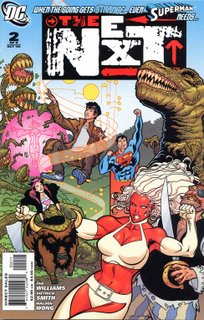
Two issues of DC's The Next (written by Tad Williams) have appeared so far, and though I've tried hard not to like the book, I have to admit that I've been won over and plan to keep reading.
The story centers upon four inter-dimensional time travelers who have escaped from their universe's murderous overlords, (an unsavory outfit called the Iron Ring). As they catapult through time, they collide with a disaffected California teen-ager named Monikka Wong, with near-disastrous results. Monikka barely survives the encounter, and when the future-nauts slow down to undo the damage, they introduce a rip into the space-time continuum. The Ring has dispatched a Very Bad Entity called the Sion to retrieve the escapees (so that they can be tortured to death). Although they should be on their way, there's a major problem: if they pack up and leave, Monikka will die.
On the positive side, Superman is working on the torn continuum problem. The travellers inform him that since they're far-future versions of us, he should help them confront Sion. Meanwhile, dinosaurs, buffaloes, and pirates roam the streets.
Dietrich Smith's art on the book is inventive, detailed, and complex; each of the travellers also sports a distinctive design. Able to acquire information about the mores of our space and time, they've selected bodies and clothing that (they think) allow them to blend in with the locals.
— Ben, the intellectual problem-solver, looks like a younger, less toxic version of Desolation Jones. (Goggles included.)
— Cindy Cindy Cindy (call her Cindy Cindy), the group's practical "people person," dresses like a 50s air hostess.
— Tweet, the creative force, looks like a present-day hipster doofus.
— Poetry Slam, the crew's destructive force (a polite term for ass-kicker), appears to have studied a wide selection of 70s blaxploitation movies and fetish porn to derive her look. (She could easily have borrowed her outfit from Emma Frost.) Slam has red skin, white hair, and sports an impressively mountainous 'fro.
On one level, Slam is every fanboy's wet-dream. But there's something else going on here, too. The Next is satirizing superheroes, their costumes, and the readers who follow (or ogle) their exploits. Slam cluelessly believes that what she is wearing is not a costume at all, but rather normal attire for a woman on earth.
And what's interesting is that Slam's enlightened companions never cast a sexualized gaze in her direction. Neither does Superman. In fact, the only character in the book who does so is Jorge (Monikka's mom's loathsome live-in boyfriend), and here's how that encounter played itself out:
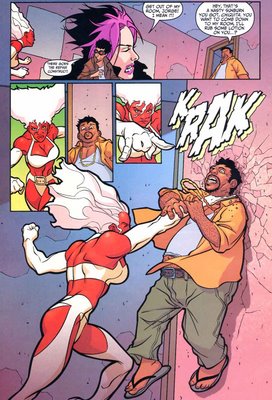
There's no denying that Slam is true to her name, and she gives Superman a run for his money when they go toe-to-toe (after he noisily barges into the apartment building where Monikka has set up a a safe-house for her companions).

Until Williams developed the character, Slam's outré costume gave me some pause. However, what's important to the narrative is not (so much) how Slam is dressed, but the way she carries herself and wields her power. Slam is fighting for a just cause; she unthinkingly acts to defend her friends at all times; and she endangers herself to protect the innocent.
And by the end of issue #2, Slam's no-questions-asked bad assery has inspired Monikka to overcome her awe of the Man of Steel and pull on his cape to get his attention during the heat of the battle. (Since Sion looks to be a formidable opponent, Monikka's intervention here is crucial.)
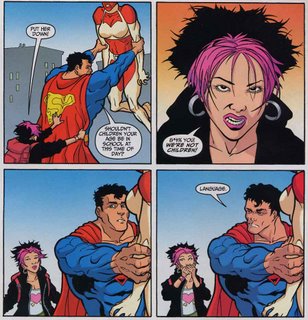 If there is such as thing as cheesecake with a complex purpose, I'd argue that Williams' Poetry Slam certainly fits the bill. Though The Next takes place outside of the mainstream continuity, the introduction of a strong positive female character (who can trade blows with Superman) actually serves to shine a light upon how women characters are written, drawn, and perceived throughout the wider DCU.
If there is such as thing as cheesecake with a complex purpose, I'd argue that Williams' Poetry Slam certainly fits the bill. Though The Next takes place outside of the mainstream continuity, the introduction of a strong positive female character (who can trade blows with Superman) actually serves to shine a light upon how women characters are written, drawn, and perceived throughout the wider DCU.Saturday, August 26, 2006
Tunnel Vision
Though I found the Red Tornado's sub-plot of interest, let me be honest and say that a single panel in JLA #1 justified the heftier-than-normal price-tag, for me.
Here it is:

I can't tell you how satisfying it was to see the core players of the DCU finally get it.
(I know Power Girl is supposed to be re-forming the JSA, and that this is probably some kind of a tease. I don't care.)
Oh, and a request to DC's writers: please stop using the Metal Men as cannon fodder.
Here it is:

I can't tell you how satisfying it was to see the core players of the DCU finally get it.
(I know Power Girl is supposed to be re-forming the JSA, and that this is probably some kind of a tease. I don't care.)
Oh, and a request to DC's writers: please stop using the Metal Men as cannon fodder.
Thursday, August 24, 2006
An 80s Marvel Heroine Chooses Sides!
(Spoilers to New Avengers #23 follow in abundance.)
In New Avengers #23, Jessica Drew (Spider Woman) makes several momentous choices, one of which involves where she stands in Marvel's Civil War.
There's a nice moment in the book in which we're shown the extent to which Drew has internalized the complexities of being a triple agent. When Nick Fury asks her which side she intends to choose, Spider-Woman doesn't skip a beat and replies: what side do you want me on?
One good thing about Civil War: Jessica Drew is now making her own choices, and how she goes about it made this a satisfying comic for me. There's action; there's intrigue; there are plausible twists and turns. And by the end of the issue, Brian Michael Bendis' transferral of Spider-Woman from the margins of the Marvel universe to its absolute center stands complete.
(Full disclosure: since a persuasive store clerk talked me into buying Spider-Woman #1 decades ago, I've been a fan of the character.)
However, the book has two draw-backs: (1) there's some of that pesky Bendis-style dialogue, and (2) there are the countless gratuitous crotch shots.
Goodness, Olivier Copiel certainly delivers the crotch shots, here. Jessica Drew is depicted in her underclothes when the issue begins, and, during the struggle that ensues with the SHIELD agents dispatched to bring her in, she engages in some serious, scantily-clad ass-kicking, which, as you might imagine, (given the logic of feminine comic book positioning and anatomical rendering), places her in a wide variety of peek-a-boo positions.
Believe me, I'm not exaggerating. I defy any objective reader to derive any other conclusion after reading this comic. Man, there's even a panel taken up entirely by the back of Drew's lower torso (actually it's a close-in shot of her panty-clad backside), and the placement of the word balloon actually makes it look as if Spider-Woman's ass is talking to Nick Fury.
Single question: would the comic have been less effective if Jessica Drew had pulled on a terry-cloth robe before she answered the knock on the door?
In New Avengers #23, Jessica Drew (Spider Woman) makes several momentous choices, one of which involves where she stands in Marvel's Civil War.
There's a nice moment in the book in which we're shown the extent to which Drew has internalized the complexities of being a triple agent. When Nick Fury asks her which side she intends to choose, Spider-Woman doesn't skip a beat and replies: what side do you want me on?
One good thing about Civil War: Jessica Drew is now making her own choices, and how she goes about it made this a satisfying comic for me. There's action; there's intrigue; there are plausible twists and turns. And by the end of the issue, Brian Michael Bendis' transferral of Spider-Woman from the margins of the Marvel universe to its absolute center stands complete.
(Full disclosure: since a persuasive store clerk talked me into buying Spider-Woman #1 decades ago, I've been a fan of the character.)
However, the book has two draw-backs: (1) there's some of that pesky Bendis-style dialogue, and (2) there are the countless gratuitous crotch shots.
Goodness, Olivier Copiel certainly delivers the crotch shots, here. Jessica Drew is depicted in her underclothes when the issue begins, and, during the struggle that ensues with the SHIELD agents dispatched to bring her in, she engages in some serious, scantily-clad ass-kicking, which, as you might imagine, (given the logic of feminine comic book positioning and anatomical rendering), places her in a wide variety of peek-a-boo positions.
Believe me, I'm not exaggerating. I defy any objective reader to derive any other conclusion after reading this comic. Man, there's even a panel taken up entirely by the back of Drew's lower torso (actually it's a close-in shot of her panty-clad backside), and the placement of the word balloon actually makes it look as if Spider-Woman's ass is talking to Nick Fury.
Single question: would the comic have been less effective if Jessica Drew had pulled on a terry-cloth robe before she answered the knock on the door?
Thoughts on Wonder Woman
(Mild spoilers to Wonder Woman #2 follow.)
Assumptions I've carried about Wonder Woman:
(1) Only a supervillain (wielding mind-control mojo) might keep Diana of Themyscira from doing her job for an entire year.
(2) The character is, simply, Diana of Themyscira.
(3) Except for impromptu missions that might absolutely require it, Diana would not plan to absent herself for an extended period without consulting with Donna Troy and Cassandra Sandsmark.
The planners behind DC's Infinite Crisis and 52 exploded the first assumption, and the re-launched series has done away with the other two.
Who is Wonder Woman? was not a question I had been posing recently. I didn't share the opinion that Diana's background and supporting cast had become overly convoluted and in drastic need of a re-launch.
And even though Themyscira has effectively ceased to exist, it's still where the character came from. Places can be erased; however, the memories, formative experiences, and the human connections tied to the place will persist. Recognition of this fact was handled much more sensitively in Supergirl #9 (believe it or not), with several characters linked to Themyscira actually dealing with it's absence.
I'm looking forward to seeing how the creative team chooses to work itself out of the various corners into which they have backed themselves by contravening these assumptions about the comic's titular character.
My really big question: why would Robin have been kept up-to-date about Diana's whereabouts and plans during the missing year, while Donna and Cassie were kept in the dark? The words thoughtless and insensitive were never ones I would have associated with Diana in the past. If it turns out that she has her reasons, they had certainly better be good ones.
A few additional observations on the first two issues of the new series:
(a) I'm disappointed that Donna Troy is so far serving as a plot device for the writer; she's simply an extended guest star/damsel-in-distress.
(b) Diana's killing of Max Lord has gone away as a legal issue, something rather clumsily revealed through the exposition/info-dump portion of issue #2.
(c) I'm finding it tiresome that each issue has been structured like a magic act, with the big trick saved for the final page.
Though I enjoy magic acts, I prefer to have the big, last page reveals in my comics accompanied by equal measures of character growth and plot development.
Assumptions I've carried about Wonder Woman:
(1) Only a supervillain (wielding mind-control mojo) might keep Diana of Themyscira from doing her job for an entire year.
(2) The character is, simply, Diana of Themyscira.
(3) Except for impromptu missions that might absolutely require it, Diana would not plan to absent herself for an extended period without consulting with Donna Troy and Cassandra Sandsmark.
The planners behind DC's Infinite Crisis and 52 exploded the first assumption, and the re-launched series has done away with the other two.
Who is Wonder Woman? was not a question I had been posing recently. I didn't share the opinion that Diana's background and supporting cast had become overly convoluted and in drastic need of a re-launch.
And even though Themyscira has effectively ceased to exist, it's still where the character came from. Places can be erased; however, the memories, formative experiences, and the human connections tied to the place will persist. Recognition of this fact was handled much more sensitively in Supergirl #9 (believe it or not), with several characters linked to Themyscira actually dealing with it's absence.
I'm looking forward to seeing how the creative team chooses to work itself out of the various corners into which they have backed themselves by contravening these assumptions about the comic's titular character.
My really big question: why would Robin have been kept up-to-date about Diana's whereabouts and plans during the missing year, while Donna and Cassie were kept in the dark? The words thoughtless and insensitive were never ones I would have associated with Diana in the past. If it turns out that she has her reasons, they had certainly better be good ones.
A few additional observations on the first two issues of the new series:
(a) I'm disappointed that Donna Troy is so far serving as a plot device for the writer; she's simply an extended guest star/damsel-in-distress.
(b) Diana's killing of Max Lord has gone away as a legal issue, something rather clumsily revealed through the exposition/info-dump portion of issue #2.
(c) I'm finding it tiresome that each issue has been structured like a magic act, with the big trick saved for the final page.
Though I enjoy magic acts, I prefer to have the big, last page reveals in my comics accompanied by equal measures of character growth and plot development.
Friday, August 18, 2006
Actually, It's Not Interesting
From Jim Beard's review of 52 #15 at Silver Bullet Comics:
My thoughts:
Mr. Beard, why speculate about something that didn't happen? Nothing is gained. It's prurient. It's not constructive. Follow your instincts, man: it can't be quantified. You say so yourself: we shouldn't even try to quantify in this way. You should have stopped there. But you didn't.
Any rape is a grave assault upon the victim's humanity and dignity: this doesn't happen by degrees. No victim's dignity is ever going to be "lightly" assaulted; so how can we speculate that one "type" of rape might be worse than another? If we follow your reasoning, we arrive at the distinctly repulsive conclusion that some rapists are worse, or better, than others. This is so stunningly idiotic that I could barely bring myself to even type it.
My thoughts on this scene:
(1) Montoya's thoroughly kicking the guy's ass barely dispelled my discomfort.
(2) I look forward to Black Adam and Isis instituting sweeping prison reforms, soon.
Hey, I'm no pollyanna. I'm aware that men and women are being forced to endure prison conditions such as those depicted in the comic as I type this. However, I prefer that the heroes in my comics eventually do something to put a stop to it.
And I expect to see it, on panel.
Renee comes too-close-for-comfort to being raped. I truly hate to say that impending sexual assault could be interesting, even if it is fiction, but like all the other moments in this series that have caused me to ponder, this moment was excrutiatingly thought-provoking. Would she have been able to resist? Would she then have been killed outright? Is rape by a male even “worse” (if such horrid acts can be quantified) to a lesbian as it would be to a straight female? How far could DC have pushed this scene if they had chosen too? It’s a tense moment. You know what’s coming, and when the guard grabs her shirt, even before she thinks about rape, you say “oh, hell…,” and you are concerned for a fictional character. Hard to do in a comic but it worked.
My thoughts:
Mr. Beard, why speculate about something that didn't happen? Nothing is gained. It's prurient. It's not constructive. Follow your instincts, man: it can't be quantified. You say so yourself: we shouldn't even try to quantify in this way. You should have stopped there. But you didn't.
Any rape is a grave assault upon the victim's humanity and dignity: this doesn't happen by degrees. No victim's dignity is ever going to be "lightly" assaulted; so how can we speculate that one "type" of rape might be worse than another? If we follow your reasoning, we arrive at the distinctly repulsive conclusion that some rapists are worse, or better, than others. This is so stunningly idiotic that I could barely bring myself to even type it.
My thoughts on this scene:
(1) Montoya's thoroughly kicking the guy's ass barely dispelled my discomfort.
(2) I look forward to Black Adam and Isis instituting sweeping prison reforms, soon.
Hey, I'm no pollyanna. I'm aware that men and women are being forced to endure prison conditions such as those depicted in the comic as I type this. However, I prefer that the heroes in my comics eventually do something to put a stop to it.
And I expect to see it, on panel.
Wednesday, August 16, 2006
Requiem for the 90s
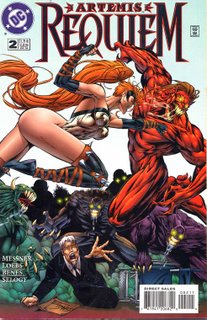
I found a copy of Artemis Requiem #2 at my local second-hand bookstore a few days ago. Upon filing it, I realized something:
I seem to be at the mid-point of a deranged quest to acquire all of the title's extant issues, with the goal being to pay no more than 75c for any single one. Presently, issues 2,3, and 4 are in my possession.
Artemis Requiem (scripted by Willaim Messner-Loebs; pencilled by Ed Benes) was published in 1996. In the second issue ("Tribes"), Artemis (just emerged from Hell, with Wonder Woman's assistance) confronts a band of graveyard-lurking white supremacists; meets up with Henrietta (Hank) Sojourner Jessup, her side-kick; joins the Hellenders; and kills a rampaging demon in the final pages.
For your enjoyment, here's the comic's indescribable splash page:
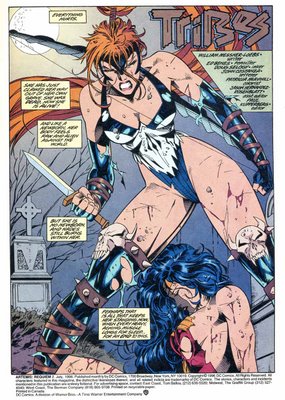
Though it looks like Artemis has just kicked Wonder Woman's ass (and torn up her bodice), that's a trick of the perspective. Artemis is actually protecting Diana, who is really, really tired.
All I can say is: What the hell happened in the 90s?
I've read the issue twice, and I still don't know why it's titled "Tribes." (Given the history between Artemis and Diana, I can figure it out, but there's no reason internal to the story to explain it.)
Offering some useful exposition later in the story, the writer actually has Artemis say this:
Six months ago I was the Wonder Woman. Three days ago I was the mistress of one of the Archdukes of Hell. Today I am a tourist in Pennsylvania. I'm amused by the weaving of the fates, but hardly excited by them anymore. And you, Hank Jessup. How came you by that name?Now, I was in graduate school during those years, and couldn't spare the time or money to read comics. So really, what's was up with all of this, then?
Tuesday, August 15, 2006
Earth's Mightiest ... Heroes

Pairing up with writer Brian Michael Bendis, the mastermind behind 2004's massively successful New Avengers, Cho says he adds one very important ingredient to the legacy of Earth's Mightiest Heroes: "Boobs." — Wizard #179, p. 40.
I write not to criticize Wizard magazine or Frank Cho, that's been done here. I merely wanted to make an observation:
— Justice League of America, pencilled by Ed Benes.
— The Mighty Avengers, pencilled by Frank Cho.
The premier superhero team books published by DC and Marvel will be pencilled by cheesecake masters. (The Mighty Avengers will be the post-Civil War iteration of the team.) Hopefully this arms race will not be operating under the doctrine of mutually assured destruction.
Benes, at least, is on record saying he will be trying to restrain himself. ("I always try to make the superheroines as beautiful as I can, but the cheesecake days are over. This is a whole new game for me — it's the JLA." — Wizard #174, p. 50.)
Monday, August 14, 2006
A Necessary Correction
From Koben Kelley's pellet review of Gail Simone's Secret Six #3 at Newsarama:
"Gail Simone continues to prove herself as the leading female in the industry ..."
That single sentence fragment raised my blood pressure to dangerous levels this morning. (Thanks, Newsarama!)
Is it so difficult for the reviewer to simply state that Gail Simone is one of the best writers presently working in comics? (Or, the best writer presently working ...?)
The reviewer's choice of words angered me. Because the language suggests that gender is a useful lens through which we can analyse or assess writing skills. (We can't.) It also suggests that the reviewer has a problem stating that Gail Simone (a girl) writes better than some of the boys. (She does. The earth hasn't reacted to this fact by destroying itself.)
Finally, I completely and utterly reject the suggestion that women writers are in a different category (or league) from men, and therefore need to be held to different standards of excellence.
"Gail Simone continues to prove herself as the leading female in the industry ..."
That single sentence fragment raised my blood pressure to dangerous levels this morning. (Thanks, Newsarama!)
Is it so difficult for the reviewer to simply state that Gail Simone is one of the best writers presently working in comics? (Or, the best writer presently working ...?)
The reviewer's choice of words angered me. Because the language suggests that gender is a useful lens through which we can analyse or assess writing skills. (We can't.) It also suggests that the reviewer has a problem stating that Gail Simone (a girl) writes better than some of the boys. (She does. The earth hasn't reacted to this fact by destroying itself.)
Finally, I completely and utterly reject the suggestion that women writers are in a different category (or league) from men, and therefore need to be held to different standards of excellence.
Thursday, August 10, 2006
The Book Meme
Having been tagged by Kalinara, I am powerless to resist.
1. One book that changed your life:
J.H. Elliott, The Count-Duke of Olivares: The Statesman in an Age of Decline, (Yale UP, 1986).
This well-researched, elegantly written book helped me decide to become a historian.
2. One book you have read more than once:
G. Cabrera Infante, Three Trapped Tigers, (Harper 1965/1971).
3. One book you would want on a desert island:
James Joyce, Ulysses, (Shakespeare and Co., 1922).
4. One book that made you laugh:
John Kennedy Toole, A Confederacy of Dunces, (LSU Press, 1980).
5. One book that made you cry:
Kashuo Ishiguro, Never Let Me Go, (Knopf, 2005).
6. One book you wish had been written:
Ibuprofen Is Not a Vitamin: Proven Relaxation Techniques for Obssessive Grad Students.
7. One book you wish had never been written:
William Archibald Dunning, Reconstruction, Political and Economic, 1865-1877, (Harper and Bros., 1907).
8. One book you are currently reading:
Paul E. Johnson, Sam Patch: The Famous Jumper, (Hill and Wang, 2003)
9. One book you have been meaning to read:
Samuel Richardson, Clarissa; or, The History of a Young Lady, (1747-8).
10. Tag five people!
The hardest part of the whole meme business. (Though I do look forward to reading people's responses.)
Nida Z.; Heidi M.; Will P.; Calvin P.; and Shelly.
1. One book that changed your life:
J.H. Elliott, The Count-Duke of Olivares: The Statesman in an Age of Decline, (Yale UP, 1986).
This well-researched, elegantly written book helped me decide to become a historian.
2. One book you have read more than once:
G. Cabrera Infante, Three Trapped Tigers, (Harper 1965/1971).
3. One book you would want on a desert island:
James Joyce, Ulysses, (Shakespeare and Co., 1922).
4. One book that made you laugh:
John Kennedy Toole, A Confederacy of Dunces, (LSU Press, 1980).
5. One book that made you cry:
Kashuo Ishiguro, Never Let Me Go, (Knopf, 2005).
6. One book you wish had been written:
Ibuprofen Is Not a Vitamin: Proven Relaxation Techniques for Obssessive Grad Students.
7. One book you wish had never been written:
William Archibald Dunning, Reconstruction, Political and Economic, 1865-1877, (Harper and Bros., 1907).
8. One book you are currently reading:
Paul E. Johnson, Sam Patch: The Famous Jumper, (Hill and Wang, 2003)
9. One book you have been meaning to read:
Samuel Richardson, Clarissa; or, The History of a Young Lady, (1747-8).
10. Tag five people!
The hardest part of the whole meme business. (Though I do look forward to reading people's responses.)
Nida Z.; Heidi M.; Will P.; Calvin P.; and Shelly.
Saturday, August 05, 2006
The Horror ...
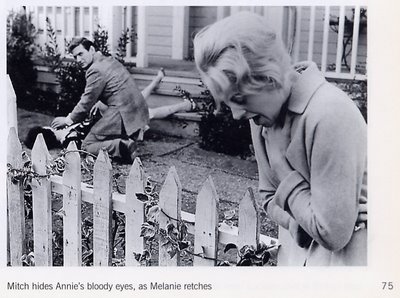
As I plan to head out and see The Descent this afternoon, scary movies have been on my mind.
I recently purchased a used copy of Camille Paglia's nifty little book on Hitchcock's The Birds in the British Film Institute's "Film Classics" series (BFI Publishing, 1998), which effectively lays out the various layers of complexity that suffuse Hitchcock's weird and scary film. The details Paglia offers are instructive in pointing up the mechanisms used to elicit fear and dread in viewers in the pre-feminist era. (Also instructive in thinkng about this is Carol Clover's fascinating Men, Women, and Chainsaws: Gender in the Modern Horror Film, [Princeton, 1992].)
There is a girl-meets-boy undercurrent running through The Birds, with viewers wondering not just who will survive, but also who will end up together? In fact, the movie sets up a love quadrangle, with the male lead, Mitch, surrounded by three attractive women who all vie for his love and attention.
One of those women is Mitch's formidable mother Lydia, played by Jessica Tandy. Tippi Hedren plays Melanie in the film; she's a somewhat feckless socialite who meets Mitch by chance and ultimately pursues him to the idyllic coastal community of Bodega Bay. (Which, it just so happens, is ground zero for an impending apocalyptic bird assault upon the human race.) Annie, played by Suzanne Pleshette, has already failed to navigate past Mitch's mother in order to establish a mature relationship with Mitch. Having accepted this defeat, she's moved to the town in which he resides just to be near him, and is the town's beloved schoolteacher. (The image above shows you what happens to her, in case you were wondering.)
With Annie gone, Melanie has a slightly clearer path to navigate to win Mitch's love. It's clearer, but it's by no means one without remaining obstacles. For in addition to Mitch's not inconsequential mother, Melanie also has to face the millions of birds who are out to kill her.
One of Hitchcock's less-savory subtexts in the film is that in order for Melanie to win Mitch and gain his mother's approval, she will need to be tamed just a bit. She's rich, she's beautiful, she's headstrong, and too used to getting her way. (Several of her mildly "wild" exploits have been reported in the press.) Luckily, a quite efficient taming force, in the form of waves of murderous birds, is on hand to do the trick.
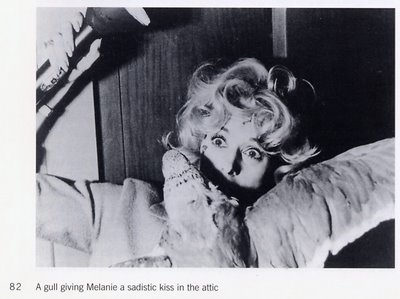
At the close of the film, "a catatonic Melanie ... must be half-carried out, where she sinks into the tender arms of an apparently all-forgiving Lydia." (p. 85)
Amor vincit omnia!
Hitchcock clearly intended for the ardors of the actual shooting of the film to reflect, and factor into, his female lead's performance. (Werner Herzog [Fitzcarraldo] and Francis Ford Coppola [Apocalypse Now!] also subjected actors and crews to hardships that mirrored those central to their own films.)
For the climatic attic scene, where Melanie falls beneath a killer flock, live gulls, crows, and ravens were used - to the surprise of Tippi Hedren, who learned only when she arrive on the set that day that ... mechanical birds had been rejected as unconvincing. Seven days were needed to shoot this horrifying sequence ... Hedren called it 'the worst week of my life.' A cage built around the set contained the birds, which were literally thrown at her from a distance of eight to ten feet by prop men wearing padded, elbow-length leather gloves. Periodically, shooting would halt while makep artist Howard Smit applied latex strips and stage blood to simulate cuts and scratches on Hedren's face and arms. Her hair was tousled, and her green suit gradually ripped. The gull that she whacks with her torch was a dummy, and the real one that bites her on the hand had a rubber cap fitted over its beak. But the terrorization of Melanie was also the terrorization of Tippi, who recalled of the grueling, day-long operations for the scene's final seconds: 'They had me down on the floor with one of the birds tied loosely to me through the peck-holes in my dress. Well one of the birds clawed my eye and that did it; I just sat and cried. It was an incredible physical ordeal.' ...In a state of total collapse, she was forbidden by her doctor to return to work, and so shooting on the film was halted for a week ... (p. 16)
While Paglia acknowledges that Melanie's character gets beaten into submission by the end of the movie, and that the shoot was pretty hellish for Tippi Hedren, she doesn't leave things there.
In closing the book, Paglia informs us of how Hedren ultimately overcame this difficult and trying experience:
Hedren and her then-husband ... later founded an animal preserve in ... California, forty miles north of Los Angeles. Though it began as a movie set, Shambala became a refuge for ... lions and tigers, whose care and adventures she chronicled in her ... 1985 book, The Cats of Shambala ...
In many interviews ... about Psycho, Janet Leigh has repeatedly expressed her continuing fear of taking showers. Tippi Hedren, in contrast, though traumatised by animal nature in The Birds, seems to have actively confronted Hitchcock's challenges. Once her 'consciousness had been raised' ... she refused to wear the fur coat Hitchcock had given her and eventually 'hocked' it to pay feed and maintenance bills at Shambala. As queen of the lions, she beat Hitchcock at his own game ...[I]n her embattled private dialogue with Hitchcock, Tippi Hedren has had the last word.
(pp. 91-3)
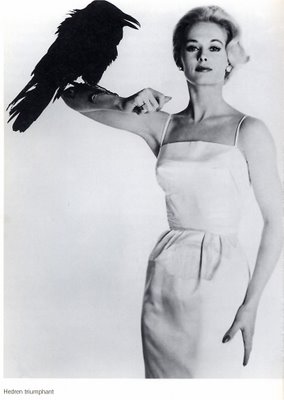
Thursday, August 03, 2006
Justice, Civil War Style
(Spoilers to Fantiastic Four #539 and Wolverine #44 follow.)
Ben Grimm's defining moment in Marvel's Civil War is depicted in Fantastic Four #539, with The Thing finally expressing his opposition to the Registration Act. But, since he just can't bring himself to defy the US government, he decides to leave the country.
The comic-book-irony quotient is especially rich, here, with Ben forced to leave the country for which he has just professed his deep love.
Sure, this is a bit of a cop out. But one of Ben's Yancy Street homies has just been killed in the struggle between the pro- and anti-registration forces, and, given the circumstances, he's entitled to revel in a pox on both your houses moment.
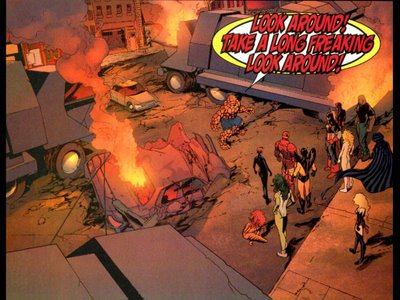
Now, I didn't have a big problem with the way that Ben actually failed to choose sides. (Though, weren't we promised that everyone would have to choose sides?) What did bother me in the issue was that during the time that The Thing is stating his views, everyone just stands around and listens to him. Cap, Iron Man, Daredevil, Ms. Marvel, She Hulk, motionlessly standing and listening.
I mean, I don't believe for a minute that Iron Man would just drop everything and listen to The Thing's tormented speechifying while Captain America, Daredevil, Luke Cage the Cloak and Dagger were all within arm's reach. The framing of this scene struck me as out of place.
These criticisms aside, though, it does seem to me that the nature of Marvel's crossover event is making it easier for writers to integrate it into their individual titles than it was for DC creators to do during Infinite Crisis. I actually get the sense that my reading of individual titles is constructively feeding into my understanding of the main issues of Civil War, which certainly wasn't the case with Infinite Crisis.
In his title, Wolverine continues to extract a pound of flesh from Nitro's genocidal hide, and it's pleasing to see that someone considers the villain, rather than the New Warriors, as responsible for the Stamford tragedy.
And while readers are reminded that who benefits? is always a crucial question to keep in mind, there was an even nicer "reveal" in the issue, one that answered a question that came to my mind when I read Civil War #1.
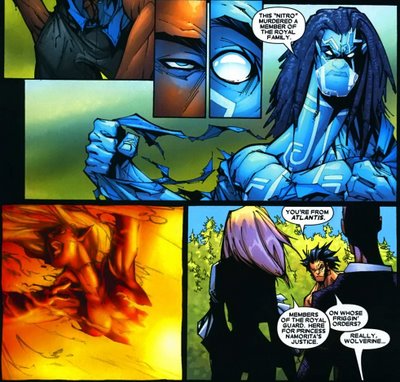
I was pleased to learn that Namorita's people are indeed interested in bringing the person responsible for her death to justice. Because, even with her bad skin and poor impulse control, Namorita was still member of the Atlantean royal house.
Ben Grimm's defining moment in Marvel's Civil War is depicted in Fantastic Four #539, with The Thing finally expressing his opposition to the Registration Act. But, since he just can't bring himself to defy the US government, he decides to leave the country.
The comic-book-irony quotient is especially rich, here, with Ben forced to leave the country for which he has just professed his deep love.
Sure, this is a bit of a cop out. But one of Ben's Yancy Street homies has just been killed in the struggle between the pro- and anti-registration forces, and, given the circumstances, he's entitled to revel in a pox on both your houses moment.

Now, I didn't have a big problem with the way that Ben actually failed to choose sides. (Though, weren't we promised that everyone would have to choose sides?) What did bother me in the issue was that during the time that The Thing is stating his views, everyone just stands around and listens to him. Cap, Iron Man, Daredevil, Ms. Marvel, She Hulk, motionlessly standing and listening.
I mean, I don't believe for a minute that Iron Man would just drop everything and listen to The Thing's tormented speechifying while Captain America, Daredevil, Luke Cage the Cloak and Dagger were all within arm's reach. The framing of this scene struck me as out of place.
These criticisms aside, though, it does seem to me that the nature of Marvel's crossover event is making it easier for writers to integrate it into their individual titles than it was for DC creators to do during Infinite Crisis. I actually get the sense that my reading of individual titles is constructively feeding into my understanding of the main issues of Civil War, which certainly wasn't the case with Infinite Crisis.
In his title, Wolverine continues to extract a pound of flesh from Nitro's genocidal hide, and it's pleasing to see that someone considers the villain, rather than the New Warriors, as responsible for the Stamford tragedy.
And while readers are reminded that who benefits? is always a crucial question to keep in mind, there was an even nicer "reveal" in the issue, one that answered a question that came to my mind when I read Civil War #1.

I was pleased to learn that Namorita's people are indeed interested in bringing the person responsible for her death to justice. Because, even with her bad skin and poor impulse control, Namorita was still member of the Atlantean royal house.
